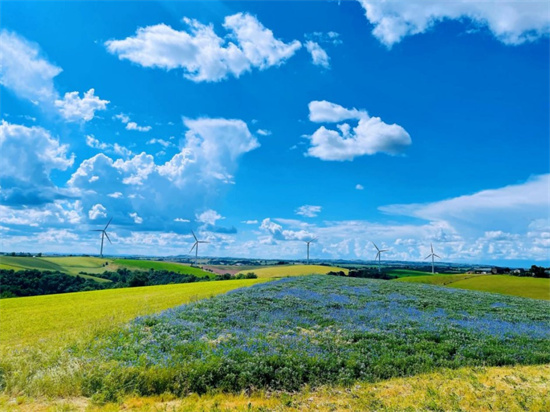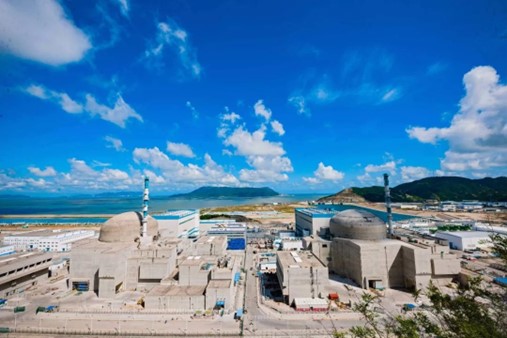China, France set exemplary model of win-win cooperation in energy sector
Energy technology is one of the key areas of cooperation between China and France. Over the past 60 years since the two countries established diplomatic relations, the two sides have leveraged their respective comparative advantages in this field and achieved fruitful innovation in energy technology.
Particularly, they have set an exemplary model of international scientific and industrial collaboration in civilian nuclear energy, oil and gas resource development, and new clean energy sectors.
As a remarkable outcome of China-France nuclear energy technology cooperation, the Daya Bay Nuclear Power Plant, located in the eastern part of Shenzhen, south China's Guangdong province, is the first million-kilowatt-class commercial nuclear power plant in the Chinese mainland. It has laid a solid foundation for China's subsequent nuclear power construction and development.
In December 1978, China announced the introduction of French nuclear power technology and equipment. Four years later, China's State Council approved the use of French nuclear power technology and equipment in the construction of the Daya Bay Nuclear Power Plant, marking the beginning of the cooperation between Chinese and French nuclear energy scientists and engineers in building the plant.

Photo shows the Assac Wind Farm developed by China General Nuclear Power Group in France. [Photo from the public account of China General Nuclear Power Group on WeChat]
Over 100 Chinese technicians were sent to France to receive training, and gain knowledge and experience in the operation, maintenance, and management of nuclear power plants. This experience led to the rapid growth of Chinese technical personnel and accelerated the progress of China's nuclear power industry.
Entering the 21st century, China and France once again joined forces in the field of nuclear energy technology and collaborated on the construction of the Taishan Nuclear Power Plant in Guangdong province, which utilizes the EPR, or European Pressurized Reactor, a third-generation nuclear power solution. It is the first EPR plant in the world.
In the realm of nuclear energy technology innovation, China and France have engaged in long-term and in-depth collaborative research. They have established multiple collaborative laboratories and jointly implemented hundreds of cooperative projects. More than 1,000 experts have been exchanged between the two sides for training, discussions, and research.
Recently, China Petrochemical Corporation (Sinopec) and French energy company TotalEnergies reached an agreement to jointly operate a new production line for the production of sustainable aviation fuel, also known as biojet fuel, using waste oils and fats.
It is reported that using biojet fuel can reduce carbon dioxide emissions by more than 50 percent compared to traditional petroleum-based aviation fuel. Sinopec holds independent intellectual property rights in the technology for the production of biojet fuel, while TotalEnergies is one of the leading sustainable aviation fuel producers in Europe. The collaboration between the two companies is expected to contribute to the green transformation of the international aviation industry and low-carbon development.

Photo shows a nuclear power plant in Taishan, south China's Guangdong province. [Photo from the public account of China General Nuclear Power Group on WeChat]
TotalEnergies is a globally renowned oil and gas company and has been deeply involved in China's oil and gas technology innovation and resource exploration and utilization.
According to Wang Wei, a researcher at the China Institute of International Studies, TotalEnergies has participated in exploration activities in China's Bohai Bay, Beibu Gulf, South China Sea, Yellow Sea, Zhujiang River Estuary Basin, and Tarim Basin. It has also made diversified investments in China's oil and gas industrial chain.
Through cooperation, TotalEnergies and its Chinese counterparts have enhanced their technological capabilities and accumulated rich experience, achieving mutual benefits and win-win outcomes.
Expanding into the international oil and gas market is one of the goals of China-France oil and gas technology cooperation. Wang stated that TotalEnergies and its Chinese counterparts learn from each other's experiences and technologies, thus forming a synergetic force. Adapting to local conditions, they have established sound partnerships in the Middle East, Africa, Latin America, and Canada for mutual benefits.
The cooperation between China and France in the field of clean energy is also flourishing. The Groix Island and its surrounding waters in northwestern France are well-known for their wind resources. About 10 kilometers away from the Groix Island, there is the site of a pioneering demonstration project for floating offshore wind power developed by China General Nuclear Power Group and its French partner, Eolfi, which covers about 20 square kilometers of sea area.

People visit the exhibition booth of China National Nuclear Corporation at the 5th World Nuclear Exhibition in Paris, France in November 2023. [Photo from the public account of China National Nuclear Corporation on WeChat]
"Europe is expected to install 50 gigawatts of floating offshore wind turbines by 2030. China General Nuclear Power Group, in collaboration with its French partner Eolfi, has taken the lead in the Groix project, showcasing their strong technological capabilities. In the future, the project will lead the development of the offshore wind power industry in France and even Europe, making contributions to the development of clean energy in Europe," said a senior executive of China General Nuclear Power Group Europe Energy.
The French company leading the offshore wind power market in China is EDF, France's leading electric utility company. In November 2021, the phase-5 of an offshore wind power project developed by the company in Dongtai, east China's Jiangsu province, in collaboration with China Energy Investment Group (CHN Energy), was connected to the power grid full-capacity and started power generation. The project is the first offshore wind power project with both domestic and foreign investment in China.
Solar photovoltaic is also one of the clean energy sources that EDF is working on in China. In early April this year, EDF's wholly-owned subsidiary, EDF Renewables, officially inaugurated its distributed photovoltaic project at the Tianjin Port Free Trade Zone. The project has a total installed capacity of 5.4 megawatts and is expected to reduce carbon dioxide emissions by over 4,500 tons annually. It is reported that EDF Renewables is currently engaged in green electricity production in more than 20 provinces in China.
























